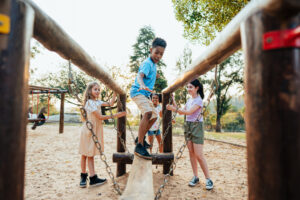The Loneliness Epidemic: Cultivating a Culture of Connection

Connection is a fundamental human need for survival. Here at KVC, we know we all need connection. Those who have studied human connection say it fits right next to our need for oxygen, food, water and shelter. So what happens when connection is limited or lost— and how can we combat loneliness with connection?
Recently, the United States Surgeon General, Dr. Vivek Murthy, released an advisory noting the public health crisis of loneliness, isolation and a lack of connection. This advisory brings to light that, as a country, our crucial need for connection is not being met, and focuses efforts on a National Strategy to Advance Social Connection. This strategy calls on individuals, governments, health systems, educational institutions, media, entertainment and community organizations to raise awareness and create practical and accessible opportunities to promote social connection and resilience.
Why is loneliness such a distinct concern today? And how can we turn a corner away from it, both in our personal lives and in our communities? Let’s explore the epidemic of loneliness in our culture today, how to break the pattern of loneliness, caregiver tips for helping children with loneliness and where to find more support.
The Impact of Loneliness on Our Culture Today
Loneliness has a significant effect on our physical, mental and emotional wellbeing. It’s a symptom that comes from losing connection to others, and with the integration of technological advances into our everyday lives, our connection opportunities have been reduced. Add into the mix the social distancing and isolation from the COVID pandemic, and it’s become clear that there’s been a drastic increase in the mental health issues surrounding loneliness, depression and suicide.
“Our epidemic of loneliness and isolation has been an underappreciated public health crisis that has harmed individual and societal health,” said the Surgeon General in his report.
“Our relationships are a source of healing and well-being hiding in plain sight — one that can help us live healthier, more fulfilled and more productive lives.” -Dr. Vivek Murthy
Addressing the issues of loneliness requires the collective efforts of individuals, companies, and communities to come together to prioritize human connection. It’s especially important to create an environment of connection for the developmental health and social wellness of children since they are more at risk for long-term effects from loneliness.
The Effects of Loneliness on Children
For young people, loneliness can have long-lasting effects. From birth to age 26, the brain is learning and developing constantly. During this time, forming healthy attachments and socially engaging with others is essential to healthy brain development. The mental health effects of loneliness and human disconnect in children have been watched closely since technology became a big part of our daily lives, but the isolation of COVID has made the effects even more profound.
 Dr. Abyssinia Tabron, Vice President of Clinical Engagement and Diversity, Equity, Inclusion and Belonging with KVC Health Systems, observes, “In the absence of opportunities for children to have direct relationships with each other, their learning environments, their teachers, coaches, etc., they were really at a deficit for an important ingredient to their healthy learning and development.” Most adults are ready to move on and repair the damage from the trauma of disconnection, but many children are still trying to process and understand what happened to the world and how it’s affecting them now. While many of us are returning to life as normal, there’s a lingering pattern of loneliness causing this epidemic. And what’s the remedy? “Relationships really are the best prescription,” says Dr. Tabron.
Dr. Abyssinia Tabron, Vice President of Clinical Engagement and Diversity, Equity, Inclusion and Belonging with KVC Health Systems, observes, “In the absence of opportunities for children to have direct relationships with each other, their learning environments, their teachers, coaches, etc., they were really at a deficit for an important ingredient to their healthy learning and development.” Most adults are ready to move on and repair the damage from the trauma of disconnection, but many children are still trying to process and understand what happened to the world and how it’s affecting them now. While many of us are returning to life as normal, there’s a lingering pattern of loneliness causing this epidemic. And what’s the remedy? “Relationships really are the best prescription,” says Dr. Tabron.
Break the Pattern of Loneliness and Cultivate Connections
While loneliness has a complex impact on our lives, the solution to loneliness isn’t complex at all. “There’s really no difficult formula for breaking the pattern of loneliness,” says Chad Anderson, Chief Clinical Officer with KVC Health Services.
“At its core, it’s pretty basic: Life is all about relationships. It’s about finding others or something you enjoy, and connecting with commonality to form relationships.” – Chad Anderson
To emphasize the importance of relationships and friendships throughout life, Anderson puts things in perspective. “The only thing that matters to people when they’re passing away is the people closest to them,” he says. “It’s their relationships, their personal connections.”
Strengthening Your Connections
 The quest for connection comes easier to some than others, of course. And it takes effort to build and sustain relationships, whether you’re an introvert, extrovert or somewhere in between.
The quest for connection comes easier to some than others, of course. And it takes effort to build and sustain relationships, whether you’re an introvert, extrovert or somewhere in between.
To offer immediate assistance with feelings of loneliness and isolation, Anderson recommends starting your journey internally: Working on coping skills and developing your mental health toolkit. Take some time to gain clarity on the types of connections that are best for you.
With that in mind, here are a few simple practices to break the pattern of loneliness and cultivate connection:
- Nurture Existing Connections: Relationships take effort to thrive. Make time for the important people in your life. Plan get-togethers, celebrate milestones and show support. Has it been a little while since you talked to someone close to you in the past? Push past the perceived awkwardness and take the first step to reach out.
- Reconnect to Activities: Consider things you have previously enjoyed, or find new places of interest, like a gym where you’ve enjoyed group fitness classes, for example. Take the initiative and make an effort to show up and form connections.
- Give Back as a Volunteer: Acts of kindness generates a boost of serotonin in both the giver and the receiver. Not only does this increase connections to others, but volunteering also gives you a sense of purpose.
- Show Empathy and Support: Reach out to others (especially if you’ve noticed someone struggling with isolation and loneliness.) You may both find a connection through the commonality of needing a connection.
- Be Open-Minded and Inclusive: Stay open to new experiences and meet new people. Forming connections with people from diverse backgrounds can help us embrace and learn from others, creating an inclusive environment where all feel welcome.
How Caregivers Can Reduce Loneliness in Children
The earlier in life that we learn to form healthy relationships, the more fulfilled our lives will feel. Caregivers are at an advantage in helping their children learn how to develop healthy connections early so that they will have those skills for a lifetime.
 Since children are still developing their capacity for healthy connections, caregivers might help their children most by focusing on the connection they have with their children. Secure and healthy attachments form first between caregivers and their children, and in an epidemic of loneliness, parents and caregivers are the first places a child will look for support. Kimberly O’Connor-Soule, KVC’s Executive Vice President of Inpatient Services, shares advice for caregivers to proactively help children deal with and push past feelings of loneliness:
Since children are still developing their capacity for healthy connections, caregivers might help their children most by focusing on the connection they have with their children. Secure and healthy attachments form first between caregivers and their children, and in an epidemic of loneliness, parents and caregivers are the first places a child will look for support. Kimberly O’Connor-Soule, KVC’s Executive Vice President of Inpatient Services, shares advice for caregivers to proactively help children deal with and push past feelings of loneliness:
- Communication is Critical: Make sure you, as a caregiver, are a safe space for your child to express themselves. Help them to open up and work through any issues or concerns with you. A strong relationship with you helps children see they can build strong relationships with others.
- Get Involved: Be a champion for your child’s connections by actively participating in and also encouraging involvement in activities: music, sports, gaming, church groups, scouting, whatever sparks excitement!
- Reach Out to School Counselor or Social Worker: The school environment is rich with opportunities for children and young adults to seek involvement and create connections with others. If you’re concerned about the loneliness your child might be experiencing, this is a good first step.
The Benefits of Caregivers Prioritizing Health, Wellness and Connection
A great way children and young adults can learn connection is by watching their caregivers. When parents and caregivers prioritize health, wellness and connection, they model that behavior and those habits for their children. It’s beneficial for adults and caregivers to take a look at their own mental health and wellness and evaluate if they could also use support. O’Connor-Soule encouragingly notes, “When you find the support you need, you will function better, and when you’re functioning better, your ability to connect to others is better.”
“A great way to focus on your personal well-being is with the five pillars of wellness,” says Sara Schlagel, Vice President of Behavioral Health Services at Camber Children’s Mental Health, part of KVC. “These pillars look at the person as a whole and put into focus the areas of life where humans feel healthy and fulfilled.” The five pillars of well-being include physical, mental, emotional, financial and social. Considering each pillar, and how we’re doing in these aspects, can help us connect to ourselves and others while providing a strategy for overall health and satisfaction.
Finding Support Through KVC
It’s critical for both children and adults struggling with isolation and loneliness to reach out and find support. As a company that practices what it preaches, KVC emphasizes creating an environment that nurtures connection for their employees and clients.
If you or a child in your care need help, KVC Health Systems is here. We provide multiple resources for those in need of support, including parenting resources, children’s mental health hospitals, individual therapy, group therapy and support groups. If another community resource is needed, KVC connects clients to those resources within the community as well. Caring for your mental health is a positive step toward improving the connection with yourself and others, and ending the epidemic of loneliness.





